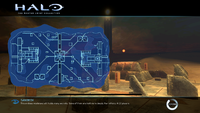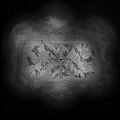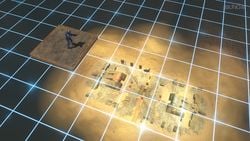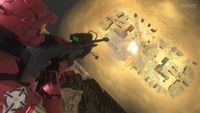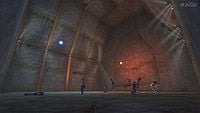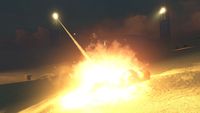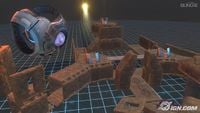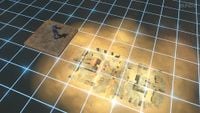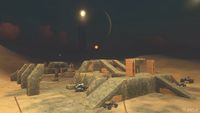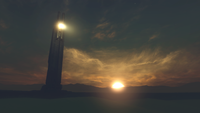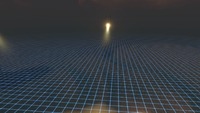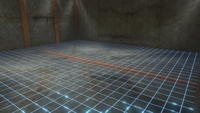Sandbox
From Halopedia, the Halo wiki
| Sandbox | |
|---|---|
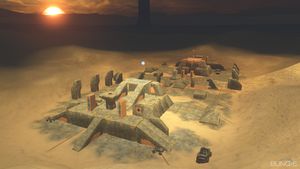
| |
| Map overview | |
|
Game: |
|
|
Map file name (?): |
|
| Lore information | |
|
Location: |
Unknown world |
| Gameplay overview | |
|
Terrain: |
Slightly eroded Forerunner structures, desert sand |
|
Recommended number of players: |
4-12 |
|
Recommended gametype(s): |
|
| “ | This endless wasteland still holds many secrets. Some of them are held more deeply than others. | ” |
Sandbox is a multiplayer map for Halo 3 included in the Mythic Map Pack and in the Halo 3 multiplayer components of the Halo 3: Mythic disc and Halo: The Master Chief Collection.
Universe and lore
Sandbox is set in the midst of a barren desert surrounded by many rolling sand dunes, similar to Sandtrap. Like Sandtrap, several Forerunner "shrine defender" towers can be seen in the distance. Bungie hinted that, similar to Sandtrap, the Covenant may have also conducted archaeological excavations here. The map is based at sunset, with a ringed gas giant in the sky, and a setting sun on the horizon.
Overview
Layout
Sandbox was designed by Bungie to be the "ultimate forging map", and as such primarily works best for use in Forge mode. To give map makers a variety of environments to play in, Sandbox is divided into three distinct levels. The main level is that of the desert, a mostly-flat area surrounded by sand similar to Sandtrap. Underneath the desert is a large underground area called The Crypt, a large flat space that allows players to do interior Forging. Above the desert area is a large level referred to as the Sky Bubble - in forge, an invisible floor allows objects to be placed hovering in the air, allowing players to build maps that players can potentially fall off. For more information on these forge-specific areas, see the Forge section below.
Despite its intended nature as a Forge canvas, Sandbox does ship on the disc with a default layout, suitable for play in larger scale games. This multiplayer variant is symmetrical in nature, taking the form of two opposing stone temples in the midst of the desert. These two bases are multi-tiered structures, with the rest of the map situated on the desert floor and offering little in the way of verticality. To the right of each base is a small bunker hosting a Battle Rifle spawn, and in front of that a small stone block hosting a Rocket Launcher. To the base's left are a Brute Shot and two Plasma Grenades. Each team spawns with a Warthog and a Chopper in their base, and a Missile Pod spawns in the front of the base. The middle of the map has a bunker below a small pillar, inside which lies a Gravity Lift pickup, allowing players to reach the Overshield found up at the top.[1]
The map, like Sandtrap, is surrounded by a series of shrine defenders, that fire lasers at players who attempt to exit the map's bounds. Each laser is an instant kill on a regular player - though heavy vehicles can take a hit or two before being destroyed. The beams are similar to those emitted by the towers on Sandtrap, though in that case, the beams trigger the Brute landmines scattered around the map rather than damage the player directly. The lasers can be blocked by standing in a bubble shield, or using Forge items to block line-of-sight.[2] Players driving the Elephant in Halo: The Master Chief Collection will be immune to the shrine defenders.
Strategies
- The Chopper is an extremely dominant vehicle on Sandbox thanks to the map's flat and open nature. Enemy Choppers should be a priority target for your team.[3]
- The Rocket Launcher is one of the most powerful weapons on Sandbox, as it is one of the few tools capable of combating the Warthog and Chopper. Using the Mongoose to pick up the Rockets can allow you to use them for advantage early in the game.[3]
- For infantry players using Battle Rifles and Carbines, the outskirts of the map can be an extremely powerful zone to pick off players engaged in firefights in the map's centre.[3]
- To control the overshield, have players on your team head to the top of your base; from here, they can fire down onto players on the enemy team and provide cover for another player to head for the overshield. With the overshield, players can then try and push for the enemy rocket launcher.[3]
- To make effective use of the Missile Pod, bring it to the higher areas of the map; this allows the missiles to do a better job of tracking their targets than the desert floor allows.[3]
Forge
- "Sandbox combines large-scale vehicular combat with a limitless amount of Forge customization. Boasting a tiered, open-world layout, “Halo 3” players will be able to build their own unique game experiences using the Forge map editor. Sandbox is a map unlike any Bungie has ever created."
- — Bungie.net[4]
The center of the main level of Sandbox is a flat, empty floor, similar to Foundry, but visually resembling Sandtrap. The map includes "just about every kind of building block you could ever want"; for example, tunnels, crouch-only doorways and quarter-pyramids are usable; see here for a full list. The item limits have been loosened; for example, unlike Foundry's 20 wall limit, it is possible to place 40 walls in Sandbox. In the standard Halo 3 game, Sandbox also supports every vehicle in Halo 3 multiplayer except the Elephant.
A new Forge item included in Sandbox is an orb of light that colors its surroundings in either red or blue; it can be used to differentiate the two bases, similar to most maps made by Bungie. Another is the Kill Ball, a large orange sphere that kills anyone who comes into contact with it. A golf club (called the 7 wood) that acts like a gravity hammer, a golf ball, and a cup to hit it into are also available. The cup is like a magnet to the golf ball; if the ball touches the grassy part of it, the ball will automatically roll into it. It takes two swings to get it back out. Like the soccer ball, it is purely for aesthetic purposes and in no way will score you a point. In Forge mode, a blue grid appears on the map to help the player place objects the way they want it with accuracy and precision. Also, it takes 3.5 seconds to fall to the bottom of the crypt (3.5x2- a potential 7 reference). It takes 10 seconds to walk from one side to the other.[1][5]
The Grid only appears in Forge, not in actual gameplay modes such as Slayer, Capture the Flag, or Infection. There are many new items to be placed in Forge. These are mostly Sandtrap-themed (as well as Ghost Town-themed wooden objects), to keep within the style of the map.[6]
Sky Bubble
The Sky Bubble is an area in Sandbox located high above the ground level. This region can be reached via built-in teleporter in Forge, allowing game-play on both the normal map and the Sky Bubble at the same time. To aid in the forging process, the Sky Bubble has another grid system to help line up objects. It should be noted that all objects besides those in the scenery menu (and turrets) will fall through the grid onto the lower level.
The Sky Bubble is about three times larger than the ground area of the default Sandbox. Although at first glance the skybubble may seem to be circular, it is actually a 36-sided regular polygon. The distance from the center to a corner of the bubble is about 66.4 grid units, making its area roughly 13,851 grid squares.
The tops of the watchtowers from the ground floor are higher than the "ground" of the Sky Bubble; they cast light over the area. When the player falls off the edge of objects he or she has placed, there is a death barrier between the Sky Bubble and the ground below, so maps like Guardian and Ascension could be accurately remade. This particular barrier has only placed under the grid area however, making it possible for players to use the outside of the Sky Bubble as a means to traverse between the ground floor without the use of a teleporter (provided that they have built a protective barrier against the watchtowers or permanently overloaded the map). Despite the huge distance, weapons capable of sniping are able to scope the distance between the ground floor and Sky Bubble with a degree of proficiency.
The Crypt
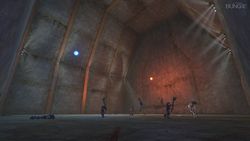
The Crypt is a large, enclosed area located under Sandbox. It can be accessed by removing the flat block in the center of the map (if you prevent it from spawning at start it will still be there and you can't delete it, can be fixed by starting a new round) and dropping down the shaft, which is very long and dark. The Crypt has the exact dimensions of a Grifball court. The floor is square-shaped and the height is the same as the width. The blue grid also appears down in the crypt.[6] The golden stripes in the Crypt's walls are covered in an alien text. Through the text, a moving, glowing texture can be seen.
The Crypt has a very high ceiling, and the walls seem to be constructed of black stone. There are UNSC floodlights in the walls that emit an eerie glow in the area. Since the Crypt can be accessed via teleporter and the shaft, it is possible to play in the Crypt, the ground level, and the Sky Bubble in one map. The Crypt measures 32 x 32 grid squares, which is approximately 16 x 16 single walls.
In Forge, the only way to access the crypt is to either remove or delete the center block that covers the shaft. Using the Flat Block forge item you can re-cover the hole, but it can be difficult to get the block back in place. A good trick would be to simply cover the hole with a flat wall, or merge other objects into the shaft via Ghost Merging. However, if you've removed all spawn points from the map you can access the crypt by changing teams until you spawn inside it.
Forge in Halo: The Master Chief Collection
For the launch of Halo 3 on Steam and Windows devices, Sandbox was one of three maps (alongside Foundry and Avalanche) given several updates to support new Forge features. Codenamed "Thorage", these changes introduce a number of new items for place on Sandbox. The map's budget has been increased from $3000 to $5000, and item costs and limits have been adjusted to allow players to build bigger and better maps on Sandbox than ever before. For example, players are able to place 50 walls of each type, unlike in the original version where players are only able to place 40 walls of a type.
Notable new additions include the Elephant, Anti-Air Wraith and a myriad of scenery objects from Avalanche, Foundry, Ghost Town and Orbital.
Achievements
The following achievement can be unlocked on Sandbox in Halo 3 and Halo: The Master Chief Collection.
| Halo 3 (Xbox 360) | Halo: MCC (Xbox One) | Halo: MCC (Steam) | Title | Unlock requirement | Games |
|---|---|---|---|---|---|
| Find the hidden on Sandbox. | Halo 3 Halo: The Master Chief Collection |
Trivia
Production notes
- Internally, Sandbox was referred to as "The Forge++ map" (likely referring to Foundry's status as a "Forge+" map), prior to the name Sandbox being decided upon.[7]
- Sandbox's successor in Halo: Reach, Forge World, originally started off development as a Sandbox remake. The original idea for the game's main forge map was to set the map in the city of New Alexandria, inside a skyscraper under construction.[8]
Glitches
- Main article: Glitches
- After overloading the map or playing on a map with the Guardian towers blocked, if you walk out towards the two towers not connected to the Guardian Wall, if you walk right into the invisible wall around them, you will be killed by the Guardians after a few seconds.
- In any of the areas inside of the map that have pools of sand on them, you can turn the sand into quicksand. Just go to a sandy area, and spawn a double block, and angle it through the sand, and it will sink and you won't be able to find it.
Easter Eggs
- Main article: Easter Eggs
- Using the Out of Sky Bubble Glitch the player may see the Sandbox Warning, which is an altered version of the Splatter Medal.
- The towers surrounding the level are paired with Da Vinci Code Objects.
- Exactly every 5 minutes, a slim red comet will soar across the sky for a second. This same Easter Egg also appears on Blackout.
- The Sandbox Skull appears on this level.
Miscellaneous
- If the player overloads Sandbox using trip mines in Forge, the grid will disappear and the Guardian towers will not fire at the player if he or she goes out of bounds, thus enabling the player to explore the level freely. Unfortunately, this will also cause the skull to disappear, and if the player enters the Sky Bubble, since the grid is gone, the game will act as if there is nothing between the Sky Bubble and the ground floor; thus causing all items to fall onto the ground. However, the death barrier is still present, and without the grid, it is much more difficult to know where it is.
Gallery

|
Browse more images in this article's gallery page. |
Sources
- ^ a b IGN: Halo 3 Mythic Map Pack Interview - Part 1
- ^ Bungie.net: Bungie Weekly Update: 02/20/09
- ^ a b c d e Halo: The Master Chief Collection Multiplayer Map Book - Sandbox, page 138-139
- ^ Bungie.net: Bungie Weekly Update: 01/30/09
- ^ Bungie.net: Sandbox Tools
- ^ a b Bungie.net: Bungie Weekly Update: 02/13/09
- ^ IGN: Halo 3 Mythic Map Pack Interview - Part 2
- ^ Bungie.net: Bungie Weekly Update 07.23.10
External links
| ||||||||||||||||||||||||||||||||||||||||
